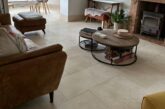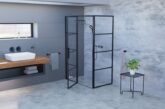Fibo UK Managing Director Scott Beattie talks to Professional Builder on fitting the company’s precision-engineered wall panels as an alternative to ceramic tiles.
With five ranges of wall panels in a choice of colours, styles and designs, Fibo’s panels are the smart way to transform kitchens, bathrooms and wetrooms. The panels can be applied directly onto walls, stud partitioning or even existing tiles, with no need to make good the walls before starting the work, saving time and money. The unique Aqualock tongue-and-groove system means the panels are up to five times quicker to fit than traditional ceramic tiling, with no grouting needed.
The panels can be fitted by anyone with basic carpentry skills, so there’s no need to subcontract the job to tilers. There are four basic steps: measure it, cut it, click it, finish it – but we’ve broken it down into the detail. The panels come in a range of sizes to offer more installers flexibility. They’re 2,400mm high and are available in 600mm, 900mm and 1,200mm widths. Using the narrower 600mm panels make it a one-man-job as they weigh less and are easier to handle in confined spaces (like bathrooms!). The profile edges are available in either white PVCu or anodised aluminium.
Step 1: Check your toolkit and the condition of the walls
![]()
All you need for almost any job where you’re fitting Fibo’s panels are the tools pictured.
Ensure you have the right sealant. Fibo’s panels must be fitted with a high-quality polymer waterproof sealant (such as Soudaseal 215LM) in every join and to all exposed edges, ensuring they are totally waterproof. Do not use clear sealant or silicone sealant. Check the walls are completely dry and (if placing panels over ceramic tiles) that the tiles are degreased.
We recommend mechanical fixing, with 1½ inch No.6 screws, and finishing with a sealant between the joins. If the walls are uneven, use battens – but check first that the wall can support a firm screw hold. Ensure a vertical batten is under every panel join.
Extra battens must be installed (whether the substrate is square or uneven) where heavy items – such as a hung basin or toilet – should be attached to the wall through the panels. The battens should be placed at 600mm or 900mm vertically, and 800m horizontally.
Step 2: Measure up and cut the panels
![]()
Measure the panels for the space and choose your cutting method.
• Jigsaw: You’ll need to use this for irregular widths or to accommodate fittings. Use a firm and stable table or work bench and cut panel with the decorative side face down.
• Handsaw: With the decorative side facing upwards, use a fine-toothed saw. The cut should only be made on the downward stroke.
• Openings/holes – eg for pipes: The hole should have minimum 5mm clearance. Seal, even if the pipe is to be fitted with a collar. For larger holes, drill first with the largest drill possible before cutting.
![]()
Step 3: For wet areas, use a base profile
![]()
In all wet areas, a base profile must be used. Height adjustments should be made where the panel meets the ceiling. Follow the instructions below for the different types of areas:
• Above a bath/shower tray or ceramic upstand: sealant must be applied in front and behind the base profile and panel, as well as between the bottom of the profile and the top of the bath, shower tray or upstand. Allow a gap of min 2-3mm under the base profile to allow for sealant expansion.
• Behind a bath or shower tray: always use a base profile between panel and floor. Seal between the underside of the profile and floor, allowing a gap of min 2-3mm to allow for expansion of the sealant. You will also need to seal where the bath or shower tray meets the panel.
Step 4: Fit the first panel
![]()
For a whole room installation and for best results, start fixing the panels in the corner furthest away from the door. Panel in both directions so the last wall to be panelled includes the door.
Fix an internal corner profile to the wall and apply sealant into both channels. Cut the tongue/groove off the edge being inserted into the profile, then cut to size from the top. Push the clean-cut panel edge firmly into the profile and fit into place.
If you’re gluing directly to walls, use a high-quality adhesive (such as No More Nails) applied to the back of the panel in a zig-zag pattern.
Step 5: Secure the panel
![]()
Screw the other side of the panel to the wall or batten along the tongue, ensuring it’s correctly aligned before securing. Screw/nail the panel into the wall using No.6 screws or gypsum-board nails, with 200mm space between them. The lowest screw/nail should be max 20mm from the bottom of the panel.
Step 6: Apply sealant and click the panels into place
![]()
Apply sealant when the panel is upright against the wall, next to the previously installed panel. Run a bead of sealant along the length of the panel groove. Lock the two panels together into position, ensuring they’re aligned.
Wipe away excess sealant immediately, then spray with methylated spirit and wipe with a damp cloth. This will ensure a virtually invisible join.
Continue along wall and apply sealant into each join before clicking panels into place with Fibo’s unique Aqualock tongue-and-groove system.
Step 7: Finishing off
![]()
To complete a full wall, you can either swing the final panel into position with the internal corner profile already attached and fasten to the stud or batten on the return wall.
Alternatively, fit the corner panel first and insert the last panel tongue-first on one side with the lip of the other edge removed to fit flush to the adjoining panel. Fix by gluing the back edge.
![]()
If you’re only applying the panels to one section of the wall, swing the final panel into position with the end profile already attached. Ensure that sealant is applied into the profile channel first.
To finish off, bathroom or kitchen accessories – such as mirrors – can be easily added once the panels are in place. Drilling a hole in a panel is straightforward and, unlike tiles, there’s no risk of cracking or shattering, so heavier items can be secured to the wall through the panel.
Maintenance is easy too. A grout-free wall means a simple wipe down will keep the panels looking good and fresh as the day of installation. The panels come with a market-leading 15-year guarantee.
The finished installation:
![]()








